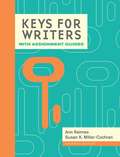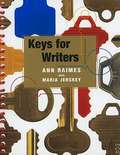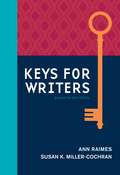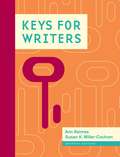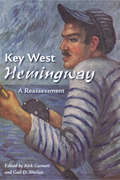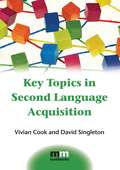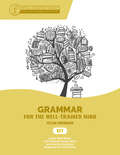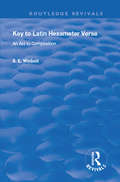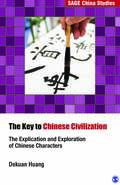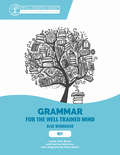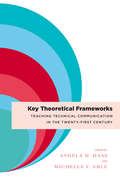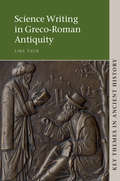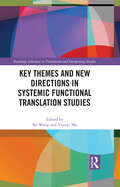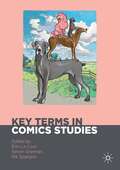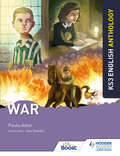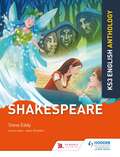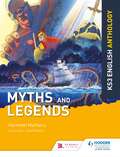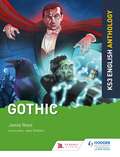- Table View
- List View
Keys for Writers with Assignment Guides (7th Edition)
by Ann Raimes Susan Miller-CochranThe seventh edition of Keys for Writers welcomes the substantial contributions of Susan Miller-Cochran as a coauthor. Susan is an Associate Professor of English and Director of the First-Year Writing Program at North Carolina State University. She earned a master's degree in teaching English as a Second Language and a doctoral degree in rhetoric and composition at Arizona State University. In addition to her writing program administration experience, she has also taught writing and ESL courses at a community college, in adult education programs, and abroad. She is also a coauthor of the Wadsworth Guide to Research. We are delighted to be working together and pooling our experience and expertise for this new edition.
Keys For Writers (Sixth Edition)
by Ann Raimes Maria JerskeyWith its simple tabbing system (five red tabs for the writing process and research, and five gold tabs for sentence-level topics), thorough and concise coverage of grammar, an easy-to-read format, and customizable KeyTabs, KEYS FOR WRITERS is a valuable resource for students in all disciplines throughout their college careers and beyond. In addition to a contemporary new design, an entirely new companion website, and a new media-enhanced e-Book, the Sixth Edition features updates and additions including new visuals, more of the book's popular "Source Shots," new student samples, MLA and APA coverage thoroughly revised to reflect their respective organizations' latest standards, and expanded coverage of topics ranging from annotated bibliographies and working with sources to visual arguments. This is an extensive and exciting revision of an effective handbook that is deservedly a best-seller!
Keys for Writers (8th Edition)
by Ann Raimes Susan K. Miller-CochranOffering a wealth of examples, tips, and tools, KEYS FOR WRITERS, 8e, is an easy-to-use resource for improving your writing for all of your coursework -- as well as your career. Color-coded tabs allow you to quickly find answers to your grammar and writing questions. The visual Critical Thinking Framework enables you to read, write, and research with better results, and Key Examples help you compare strong versus weak ways of applying critical thinking. Sample student papers provide excellent models of writing in different disciplines, while the new Assignment Guide provides steps for writing in 15 common genres you might encounter in your academic and professional career. Completely up to date with the latest MLA guidelines, the eighth edition also highlights the importance of writing in such careers as nursing, accounting, law, IT, and more.
Keys for Writers 7th Edition
by Ann Raimes Susan K. Miller-CochranKEYS FOR WRITERS is a valuable resource for students in all disciplines throughout their college careers and beyond. The authors' concise presentation of key concepts, such as the writing process, critical thinking, grammar fundamentals, and integration and acknowledgment of sources, can help students in all college disciplines as well as in the workplace.
Key West Hemingway: A Reassessment
by Kirk Curnutt Gail D. Sinclair"No other work has focused so sharply and revealed so clearly the vitality of Hemingway's time in Key West. Key West Hemingway shows that even as his Papa persona grew during the 1930s, Hemingway continued to generate a significant body of nuanced and complex (if also misunderstood) experimental prose. With keen scrutiny and brilliance, these fresh and readable essays rediscover and give us Hemingway's multifaceted American literary voices."--Linda Patterson Miller, editor of Letters from the Lost Generation "This impressive and cohesive collection of essays on Hemingway's Key West works and days puts into proper critical and biographical perspective one of the least understood yet most productive periods in his life. Husband, lover, father, son, fisherman, political activist, defender of the vets, essayist, and crafter of fiction--it's all here, close-up and wide-angle, the American Hemingway of 1928-1940, in all his facets, the rough diamond in the Florida sun."--Allen Josephs, author of Ritual and Sacrifice in the Corrida Conventional wisdom holds that Hemingway's Key West years were among his least productive, and many are dismissive of the works he produced during that time. In this collection, several leading Hemingway scholars focus on his overlooked short stories and essays, especially those written for Esquire from 1933 to 1936. They demonstrate how the island inspired some of his most vivid work and discuss how the "Hemingway industry" continues to endure. Kirk Curnutt is professor and chair of English at Troy University. Gail D. Sinclair is scholar in residence and executive director of the Winter Park Institute at Rollins College. Contributors: Patrick Hemingway | Carol Hemingway | Lawrence R. Broer | Gail D. Sinclair | Milton A. Cohen | Dan Monroe | Susan F. Beegel | Steve Paul | Mark P. Ott | Susan J. Wolfe | Mimi Reisel Gladstein | Michael J. Crowley | John J. Fenstermaker | E. Stone Shiftlet | Kirk Curnutt | James H. Meredith | Nicole Camastra | Russ Pottle
Key Topics in Sociolinguistics: Languages in Contact
by Lim, Lisa and Ansaldo, Umberto Lisa Lim Umberto AnsaldoIntroducing new findings from popular culture, the globalised new economy and computer-mediated communication, this is a fascinating study of contact between languages in modern societies. Ansaldo and Lim bring together research on multilingualism, code-switching, language endangerment, and globalisation, into a comprehensive overview of world Englishes and creoles. Illustrated with a wide range of original examples from typologically diverse languages, including Sinitic, Autronesian, Dravidian and other non-Indo-European varieties, the book focuses on structural analyses of Asian ecologies and their relevance for current theories of contact phenomena. Full of new insights, it is essential reading for students and researchers across linguistics, culture and communication.
Key Topics in Sociolinguistics: Language Maintenance and Shift
by Anne PauwelsWhat motivates some linguistic minorities to maintain their language? Why do others shift away from it rather quickly? Are there specific conditions - environmental or personal - influencing these dynamics? What can families and communities do to pass on their 'threatened' language to the next generation? These and related questions are investigated in detail in Language Maintenance and Shift. In this fascinating book, Anne Pauwels analyses the patterns of language use exhibited by individuals and groups living in multilingual societies, and explores their efforts to maintain their heritage or minority language. She explores the various methods used to analyse language maintenance, from linguistic demography to linguistic biography, and offers guidance on how to research the language patterns and practices of linguistic minorities around the world.
Key Topics in Second Language Acquisition
by Vivian Cook David SingletonThis textbook offers an introductory overview of eight hotly-debated topics in second language acquisition research. It offers a glimpse of how SLA researchers have tried to answer common questions about second language acquisition rather than being a comprehensive introduction to SLA research. Each chapter comprises an introductory discussion of the issues involved and suggestions for further reading and study. The reader is asked to consider the issues based on their own experiences, thus allowing them to compare their own intuitions and experiences with established research findings and gain an understanding of methodology. The topics are treated independently so that they can be read in any order that interests the reader.
Key to Yellow Workbook: A Complete Course For Young Writers, Aspiring Rhetoricians, And Anyone Else Who Needs To Understand How English Works (Grammar for the Well-Trained Mind #0)
by Audrey Anderson Susan Wise Bauer Jessica OttoThe Key to Yellow Workbook gives clear, thoroughly-explained answers to all exercises in the Yellow Workbook, one of four non-sequential workbooks in the Grammar for the Well-Trained Mind series, providing detailed, well-designed exercises in the correct use of English grammar for middle-school and high-school level students, as well as grammar aficionados of any age. The Key to Yellow Workbook gives clear, thoroughly-explained answers to all exercises in the Yellow Workbook, one of four non-sequential books in the Grammar for the Well-Trained Mind series, providing detailed, well-designed exercises in the correct use of English grammar. The Key, along with the accompanying Yellow Workbook and the Core Instructor Text, make up Grammar for the Well-Trained Mind: a complete course that takes students from basic definitions (“A noun is the name of a person, place, thing, or idea”) through advanced sentence structure and analysis, all the grammar skills needed to write and speak with eloquence and confidence. This innovative program combines the three essential elements of language learning: understanding and memorizing rules (prescriptive teaching), repeated exposure to examples of how those rules are used (descriptive instruction), and practice using those rules in exercises and in writing (practical experience). Each year, parents and teachers go through the dialogue, rules, and examples in the Core Instructor Text; students follow along in the Workbook. This repetition solidifies the concepts, definitions, and examples in the student’s mind. There are four Workbooks, one for each year. Each Workbook contains the same rules and examples, but four completely different sets of exercises and assignments, allowing students to develop a wide-ranging knowledge of how the rules and examples are put to use in writing. Each Key to the Workbooks provides not only answers, but also explanations for the parent/instructor, and guidance as to when the answers might be ambiguous (as, in English, they often are). All of the rules covered, along with the repeated examples for each, are assembled for ongoing reference in The Grammar Guidebook. Every step of the sentence diagramming process is gathered for reference, along with illustrations, in The Diagramming Dictionary. These will become the student’s indispensable guide to writing through high school, into college and beyond. Step-by-step instruction takes students from the most basic concepts through advanced grammatical concepts such as modal and hortative verbs and multiple functions of noun clauses. Extensive diagramming exercises reinforce the rules and help technical and visual learners to understand and use the English language effectively. Each step of the diagramming process is illustrated and thoroughly explained to the student. Text for examples and exercises are drawn from great works of literature, as well as from well-written nonfiction texts in science, mathematics, and the social sciences. Regular review is built into each year of work. The Key accompanies one of four non-sequential workbooks, each containing new exercises that allow students to practice and apply the grammar principles under study.
Key to Latin Hexameter Verse: An Aid to Composition (Routledge Revivals)
by S. E. WinboltOriginally published in 1903.
The Key to Chinese Civilization: The Explication and Exploration of Chinese Characters (SAGE China Studies)
by Dekuan HuangThe Key to Chinese Civilization: The Explication and Exploration of Chinese Characters is a fascinating guide to the history of the Chinese civilization, which has been recorded not just by means of the Chinese characters but also in the characters themselves. It studies the long history of Chinese characters, the laws of their construction and development, and what their correct interpretation can mean for contemporary communication. The Chinese writing system, vastly different from phonetic alphabet systems and the oldest continuously used system of writing in the world, is dynamic and its evolution reveals much about the historical and sociocultural development of China. The book shows how the interpretation of the cultural connotation of Chinese characters is necessary, even crucial, though it is a daunting task. It proposes a scientific method for this kind of interpretation and gives elaborate examples. Authored by an expert in philology and palaeography, the book is written in simple language and will be of great help to Chinese language enthusiasts.
Key to Blue Workbook: A Complete Course For Young Writers, Aspiring Rhetoricians, And Anyone Else Who Needs To Understand How English Works (Grammar for the Well-Trained Mind #9)
by Susan Wise BauerThe Key to the Blue Workbook gives clear, thoroughly-explained answers to all exercises in the Blue Workbook, one of four workbooks in the Grammar for the Well-Trained Mind series, providing detailed, well-designed exercises in the correct use of English grammar. The Key to the Blue Workbook gives clear, thoroughly-explained answers to all exercises in the Blue Workbook, one of four non-sequential books in the Grammar for the Well-Trained Mind series, providing detailed, well-designed exercises in the correct use of English grammar. The Key, along with the accompanying Blue Workbook and the Core Instructor Text, make up Grammar for the Well-Trained Mind: a complete course that takes students from basic definitions (“A noun is the name of a person, place, thing, or idea”) through advanced sentence structure and analysis, all the grammar skills needed to write and speak with eloquence and confidence. This innovative program combines the three essential elements of language learning: understanding and memorizing rules (prescriptive teaching), repeated exposure to examples of how those rules are used (descriptive instruction), and practice using those rules in exercises and in writing (practical experience). Each year, parents and teachers go through the dialogue, rules, and examples in the Core Instructor Text; students follow along in the Workbook. This repetition solidifies the concepts, definitions, and examples in the student’s mind. There are four Workbooks, one for each year. Each Workbook contains the same rules and examples, but four completely different sets of exercises and assignments, allowing students to develop a wide-ranging knowledge of how the rules and examples are put to use in writing. Each Key to the Workbooks provides not only answers, but also explanations for the parent/instructor, and guidance as to when the answers might be ambiguous (as, in English, they often are). All of the rules covered, along with the repeated examples for each, are assembled for ongoing reference in the Comprehensive Handbook of Rules (soon to be renamed as The Grammar Guidebook). Every step of the sentence diagramming process is gathered for reference, along with illustrations, in The Diagramming Dictionary. These will become the student’s indispensable guide to writing through high school, into college and beyond. Step-by-step instruction takes students from the most basic concepts through advanced grammatical concepts such as modal and hortative verbs and multiple functions of noun clauses. Extensive diagramming exercises reinforce the rules and help technical and visual learners to understand and use the English language effectively. Each step of the diagramming process is illustrated and thoroughly explained to the student. Text for examples and exercises are drawn from great works of literature, as well as from well-written nonfiction texts in science, mathematics, and the social sciences. Regular review is built into each year of work. The Key accompanies one of four non-sequential workbooks, each containing new exercises that allow students to practice and apply the grammar principles under study.
Key Theoretical Frameworks: Teaching Technical Communication in the Twenty-First Century
by Godwin Y. Agboka Matthew Cox Marcos Del Hierro Jessica Edwards Erin A. Frost Elise Verzosa Hurley Natasha N. Jones Cruz Medina Marie E. Moeller Kristen R. Moore Donnie Johnson Sackey Gerald Savage J. Blake Scott Barbi Smyser-Fauble Kenneth Walker Rebecca WaltonDrawing on social justice methodologies and cultural studies scholarship, Key Theoretical Frameworks offers new curricular and pedagogical approaches to teaching technical communication. Including original essays by emerging and established scholars, the volume educates students, teachers, and practitioners on identifying and assessing issues of social justice and globalization. The collection provides a valuable resource for teachers new to translating social justice theories to the classroom by presenting concrete examples related to technical communication. Each contribution adopts a particular theoretical approach, explains the theory, situates it within disciplinary scholarship, contextualizes the approach from the author’s experience, and offers additional teaching applications. The first volume of its kind, Key Theoretical Frameworks links the theoretical with the pedagogical in order to articulate, use, and assess social justice frameworks for designing and teaching courses in technical communication. Contributors: Godwin Y. Agboka, Matthew Cox, Marcos Del Hierro, Jessica Edwards, Erin A. Frost, Elise Verzosa Hurley, Natasha N. Jones, Cruz Medina, Marie E. Moeller, Kristen R. Moore, Donnie Johnson Sackey, Gerald Savage, J. Blake Scott, Barbi Smyser-Fauble, Kenneth Walker, Rebecca Walton
Key Themes in Ancient History: Language and Society in the Greek and Roman Worlds
by James ClacksonTexts written in Latin, Greek and other languages provide ancient historians with their primary evidence, but the role of language as a source for understanding the ancient world is often overlooked. Language played a key role in state-formation and the spread of Christianity, the construction of ethnicity, and negotiating positions of social status and group membership. Language could reinforce social norms and shed light on taboos. This book presents an accessible account of ways in which linguistic evidence can illuminate topics such as imperialism, ethnicity, social mobility, religion, gender and sexuality in the ancient world, without assuming the reader has any knowledge of Greek or Latin, or of linguistic jargon. It describes the rise of Greek and Latin at the expense of other languages spoken around the Mediterranean and details the social meanings of different styles, and the attitudes of ancient speakers towards linguistic differences.
Key Themes in Ancient History: Science Writing in Greco-Roman Antiquity
by Liba TaubWe access Greek and Roman scientific ideas mainly through those texts which happen to survive. By concentrating only on the ideas conveyed, we may limit our understanding of the meaning of those ideas in their historical context. Through considering the diverse ways in which scientific ideas were communicated, in different types of texts, we can uncover otherwise hidden meanings and more fully comprehend the historical contexts in which those ideas were produced and shared, the aims of the authors and the expectations of ancient readers. Liba Taub explores the rich variety of formats used to discuss scientific, mathematical and technical subjects, from c. 700 BCE to the sixth century CE. Each chapter concentrates on a particular genre - poetry, letter, encyclopaedia, commentary and biography - offering an introduction to Greek and Roman scientific ideas, while using a selection of ancient writings to focus on the ways in which we encounter them.
Key Themes and New Directions in Systemic Functional Translation Studies (Routledge Advances in Translation and Interpreting Studies)
by Bo WangThis collection features eight interviews with seven senior scholars, whose seminal works involve the application of Systemic Functional Linguistica (SFL) to translation studies have advanced Systemic Functional Translation Studies (SFTS) as a research agenda in its own right, with critical reflections and insights into future directions. The book introduces SFTS as a research field, tracing its development and situating the contributions of the scholars interviewed within this tradition. An international group of researchers working across a diverse range of topics within SFTS are interviewed, including Christian M.I.M. Matthiessen, Erich Steiner, J.R. Martin, Juliane House, Jeremy Munday, Adriana Pagano and Akila Sellami-Baklouti. Taken together, the collection offers a comprehensive account of theoretical and methodological developments in SFTS, with critical overviews of these scholars’ body of work within the research area and reflections on the emerging research that pushes SFTS scholarship into new frontiers. This volume will be of particular interest to scholars in translation studies and Systemic Functional Linguistics, as well as those interested in innovations in linguistic theory.
Key Terms in Comics Studies (Palgrave Studies in Comics and Graphic Novels)
by Simon Grennan Erin La Cour Rik SpanjersKey Terms in Comics Studies is a glossary of over 300 terms and critical concepts currently used in the Anglophone academic study of comics, including those from other languages that are currently adopted and used in English. Written by nearly 100 international and contemporary experts from the field, the entries are succinctly defined, exemplified, and referenced. The entries are 250 words or fewer, placed in alphabetical order, and explicitly cross-referenced to others in the book. Key Terms in Comics Studies is an invaluable tool for both students and established researchers alike.
Key Stage 3 English Anthology: War
by Paula AdairInspire your teaching with Key Stage 3 English Anthology: War, a themed anthology for Year 8.Featuring a moving mixture of poetry and prose, this Anthology guides students through a variety of extracts encouraging them to connect with the text to gain a thorough understanding of the context and literary techniques underpinning each piece of work.Each extract is supported by Teaching and Learning Resources, including quizzes, lesson plans and PowerPoint slides to help you implement the content of the book.Each extract includes:- A context panel to provide key information to set the scene of each extract- Glossaries and annotations to help students work through each extract confidently- Look closer: key questions for students to consider as they work through the extracts- Now try this: writing and speaking activities to encourage students to get creative and actively engage with the text- Fast finisher tasks to support students who race ahead- A practice question to familiarise students with the command words they will see at GCSE
Key Stage 3 English Anthology: War
by Paula AdairInspire your teaching with Key Stage 3 English Anthology: War, a themed anthology for Year 8.Featuring a moving mixture of poetry and prose, this Anthology guides students through a variety of extracts encouraging them to connect with the text to gain a thorough understanding of the context and literary techniques underpinning each piece of work.Each extract is supported by Teaching and Learning Resources, including quizzes, lesson plans and PowerPoint slides to help you implement the content of the book.Each extract includes:- A context panel to provide key information to set the scene of each extract- Glossaries and annotations to help students work through each extract confidently- Look closer: key questions for students to consider as they work through the extracts- Now try this: writing and speaking activities to encourage students to get creative and actively engage with the text- Fast finisher tasks to support students who race ahead- A practice question to familiarise students with the command words they will see at GCSE
Key Stage 3 English Anthology: Shakespeare
by Steve EddyInspire your teaching with Key Stage 3 English Anthology: Shakespeare, a themed anthology for Year 7 through to Year 9. Featuring key extracts from A Midsummer Night's Dream, Romeo and Juliet and Macbeth, the Anthology guides students through each play, encouraging them to engage with the text to gain a thorough understanding of the context and literary techniques underpinning Shakespeare's work. Each extract is supported by Teaching and Learning Resources, including quizzes, lesson plans and PowerPoint slides to help you implement the content of the book. Each extract includes:- A context panel to provide key information to set the scene of Elizabethan England- Glossaries and annotations to help students work through each extract confidently - Look closely: key questions for students to consider as they work through the extracts- Now try this: writing and speaking activities to encourage students to get creative and actively engage with the text- Fast finisher tasks to support students who race ahead- A practice question to familiarise students with the command words they will see at GCSE
Key Stage 3 English Anthology: Shakespeare
by Steve Eddy Jane SheldonInspire your teaching with Key Stage 3 English Anthology: Shakespeare, a themed anthology for Year 7 through to Year 9. Featuring key extracts from A Midsummer Night's Dream, Romeo and Juliet and Macbeth, the Anthology guides students through each play, encouraging them to engage with the text to gain a thorough understanding of the context and literary techniques underpinning Shakespeare's work. Each extract is supported by Teaching and Learning Resources, including quizzes, lesson plans and PowerPoint slides to help you implement the content of the book. Each extract includes:- A context panel to provide key information to set the scene of Elizabethan England- Glossaries and annotations to help students work through each extract confidently - Look closely: key questions for students to consider as they work through the extracts- Now try this: writing and speaking activities to encourage students to get creative and actively engage with the text- Fast finisher tasks to support students who race ahead- A practice question to familiarise students with the command words they will see at GCSE
Key Stage 3 English Anthology: Myths and Legends
by Harmeet MatharuInspire your teaching with Key Stage 3 English Anthology: Myths and Legends, a themed anthology for Year 7.Featuring myths such as The Odyssey and legends such as King Arthur, this Anthology guides students through fiction, non-fiction and poetry, encouraging them to connect with a variety of texts to gain a thorough understanding of the context and literary techniques underpinning each piece.Each extract is supported by Teaching and Learning Resources, including quizzes, lesson plans and PowerPoint slides to help you implement the content of the book.Each extract includes:- A context panel to provide key information to set the scene of each myth- Glossaries and annotations to help students work through each extract confidently- Look closer: key questions for students to consider as they work through the extracts- Now try this: writing and speaking activities to encourage students to get creative and actively engage with the text- Fast finisher tasks to support students who race ahead- A practice question to familiarise students with the command words they will see at GCSE
Key Stage 3 English Anthology: Myths and Legends
by Harmeet Matharu Jane SheldonInspire your teaching with Key Stage 3 English Anthology: Myths and Legends, a themed anthology for Year 7.Featuring myths such as The Odyssey and legends such as King Arthur, this Anthology guides students through fiction, non-fiction and poetry, encouraging them to connect with a variety of texts to gain a thorough understanding of the context and literary techniques underpinning each piece.Each extract is supported by Teaching and Learning Resources, including quizzes, lesson plans and PowerPoint slides to help you implement the content of the book.Each extract includes:- A context panel to provide key information to set the scene of each myth- Glossaries and annotations to help students work through each extract confidently- Look closer: key questions for students to consider as they work through the extracts- Now try this: writing and speaking activities to encourage students to get creative and actively engage with the text- Fast finisher tasks to support students who race ahead- A practice question to familiarise students with the command words they will see at GCSE
Key Stage 3 English Anthology: Gothic
by Jamie ReesInspire your teaching with Key Stage 3 English Anthology: Gothic, a themed anthology for Year 8.Featuring texts full of suspense, horror and gloom such as Frankenstein and Dracula, this anthology guides students through fiction, non-fiction and poetry encouraging them to connect with a variety of texts to gain a thorough understanding of the context and literary techniques underpinning each piece of work.Each extract is supported by Teaching and Learning Resources, including quizzes, lesson plans and PowerPoint slides to help you implement the content of the book.Each extract includes:- A context panel to provide key information to set the scene of each extract- Glossaries and annotations to help students work through each extract confidently- Look closer: key questions for students to consider as they work through the extracts- Now try this: writing and speaking activities to encourage students to get creative and actively engage with the text- Fast finisher tasks to support students who race ahead- A practice question to familiarise students with the command words they will see at GCSE
Key Stage 3 English Anthology: Gothic
by Jamie Rees Jane SheldonInspire your teaching with Key Stage 3 English Anthology: Gothic, a themed anthology for Year 8.Featuring texts full of suspense, horror and gloom such as Frankenstein and Dracula, this anthology guides students through fiction, non-fiction and poetry encouraging them to connect with a variety of texts to gain a thorough understanding of the context and literary techniques underpinning each piece of work.Each extract is supported by Teaching and Learning Resources, including quizzes, lesson plans and PowerPoint slides to help you implement the content of the book.Each extract includes:- A context panel to provide key information to set the scene of each extract- Glossaries and annotations to help students work through each extract confidently- Look closer: key questions for students to consider as they work through the extracts- Now try this: writing and speaking activities to encourage students to get creative and actively engage with the text- Fast finisher tasks to support students who race ahead- A practice question to familiarise students with the command words they will see at GCSE
